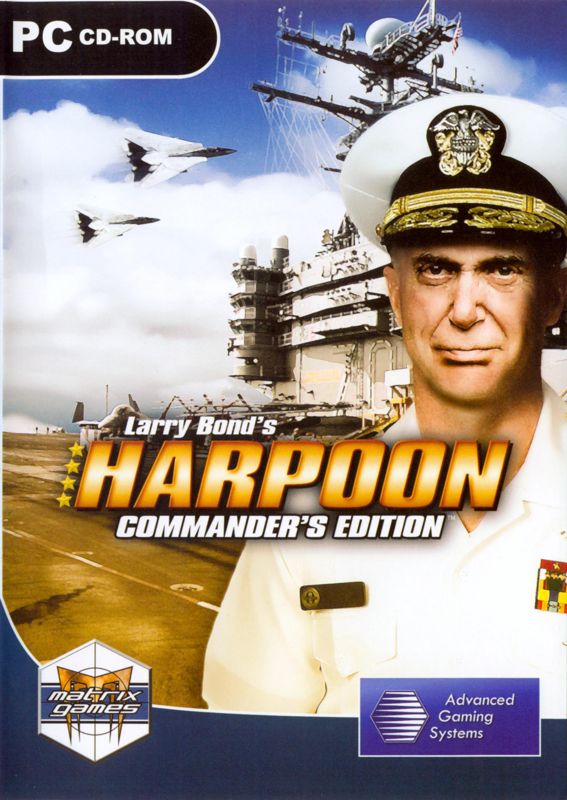Retro Replay Review
Gameplay
Larry Bond’s Harpoon: Commander’s Edition remains the gold standard for naval wargame aficionados, offering an unparalleled depth of simulation that few contemporary titles can match. From carrier battle groups to submarine patrols, every platform behaves according to realistic performance parameters—speed, sensor ranges, weapon envelopes and fuel endurance are all modeled with meticulous care. The learning curve can be steep, but for those willing to invest the time, the payoff is a simulation that feels both authentic and rewarding.
(HEY YOU!! We hope you enjoy! We try not to run ads. So basically, this is a very expensive hobby running this site. Please consider joining us for updates, forums, and more. Network w/ us to make some cash or friends while retro gaming, and you can win some free retro games for posting. Okay, carry on 👍)
This edition introduces several notable improvements over the long-standing Harpoon Classic 2002 Gold build. Functional Electronic Countermeasures (ECM) now operate with dynamic detection and jamming algorithms, forcing players to think tactically about emissions control (EMCON) and electronic warfare. The inclusion of mobile ground units also opens up new amphibious and littoral scenarios where army air defenses and missile batteries must be managed alongside traditional naval forces.
The new WestPac BattleSet provides a fresh theater of operations, pitting regional powers in Southeast Asian waters against each other in tense hypothetical engagements. Coupled with an updated database—current as of early 2008—unit statistics, equipment lists and order-of-battle details reflect modern capabilities and inventories. Frequent bug fixes and quality–of–life tweaks ensure that even the most obscure corner cases or rare weapon interactions behave as intended.
Graphics
Visually, Harpoon: Commander’s Edition retains its classic 2D map interface, eschewing flashy 3D models in favor of clarity and precision. Unit icons are crisply drawn and color–coded by nation, allowing you to rapidly assess the tactical situation at a glance. Grid lines, range rings and bearing indicators overlay seamlessly, turning the chart plotter feel into a fully functional tactical display.
While purists might lament the lack of photorealistic textures, the minimalistic aesthetic is well suited to real-time planning and command decisions. Zooming and panning remain fluid, and new map overlays—such as refined bathymetry contours for littoral operations—add valuable strategic context. Even the in-game menu windows have received polish, with improved font rendering and collapsible panels that reduce screen clutter.
Special effects for torpedo wakes, gunfire flashes, and missile trails have been subtly enhanced, providing a bit more visual feedback during engagements. These are never overbearing; rather, they underscore the high–stakes nature of naval combat. All told, the graphics serve their purpose admirably, enabling high–speed plotting while preserving the “board game” charm that longtime fans adore.
Story
As a pure wargame, Harpoon doesn’t offer a narrative-driven campaign in the traditional sense. Instead, it relies on scenario briefings and strategic objectives to frame each encounter. The WestPac set, for instance, lays out several “what-if” confrontations in the South China Sea—ranging from Cold War–style standoffs to modern resource disputes—complete with political backgrounders and force dispositions.
Players create their own unfolding drama by making command decisions under pressure. A failed interception can rapidly cascade into a full-scale engagement; a clever flanking maneuver might yield strategic surprise. The emergent narratives born from these player-driven outcomes often prove more compelling than any scripted storyline could provide, giving the game a “you are there” intensity.
The extensive database coupling and the scenario editor also enable users to craft custom engagements—importing new orders of battle, adjusting unit loads, or defining alternate historical axes of conflict. This sandbox approach encourages creativity and enhances replay value, ensuring that the game’s unfolding “story” remains fresh well beyond the initial missions.
Overall Experience
Harpoon: Commander’s Edition delivers an extraordinary level of fidelity for naval warfare enthusiasts, and while it demands patience, its strategic depth is unmatched. Whether you’re orchestrating fleet movements in the open ocean or managing littoral fire support against shore defenses, the simulation framework remains rock-solid. The steady stream of updates—two to three per year—illustrates the developers’ commitment to maintaining and improving the experience over time.
The collaborative spirit of the Harpoon community further enriches the package. Active forums on Matrix Games and AGSI host user-created scenarios, updated unit databases and tactical guides that can shorten the learning curve. If you ever feel overwhelmed, a trove of tutorials and mod files is only a few clicks away, ensuring that new players can steadily grow into offline and PBEM specialists.
In an era dominated by high–octane action titles, Harpoon: Commander’s Edition stands as a testament to the enduring appeal of thoughtful, methodical wargaming. It may not dazzle with cutting–edge visuals or cinematic cutscenes, but for anyone seeking the ultimate in naval command simulation, it remains the benchmark against which all others are measured. Highly recommended for serious strategists and history buffs alike.
 Retro Replay Retro Replay gaming reviews, news, emulation, geek stuff and more!
Retro Replay Retro Replay gaming reviews, news, emulation, geek stuff and more!




Reviews
There are no reviews yet.